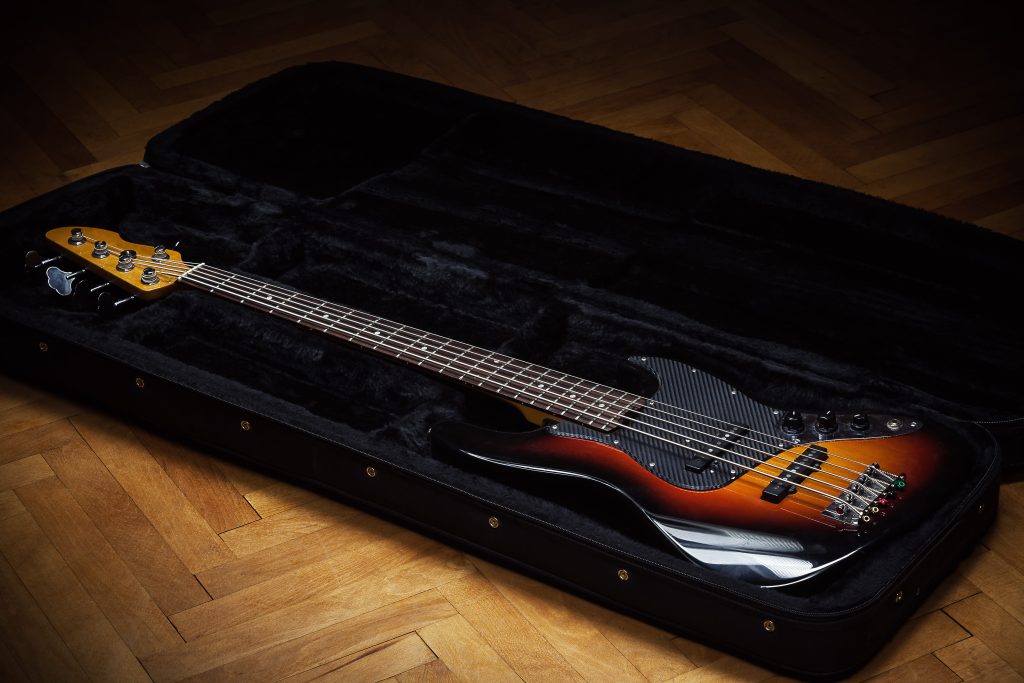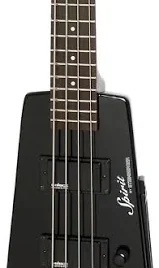Best Bass Guitar Case
Protecting your prized Instrument is something that a quality instrument deserves. Finding the best bass guitar case isn’t only about protection. Choosing the right bass case involves more than just physical safeguarding – this involves peace of mind when transporting your cherished gear.
Whether you’re playing local gigs or beginning world tours, the right case can mean the difference between flawless performances and costly repairs. But bass cases aren’t one-size-fits-all.
What works perfectly for a vintage Fender might be excessive for a beginner’s Squier. By the end, you’ll have the knowledge to select the ideal case to keep your bass safe and sound for years to come.
This post may contain affiliate links, which means I may earn a small commission at no extra cost to you if you make a purchase through these links. As an affiliate, I only recommend products or services I trust and believe will provide value to my readers.
The Great Debate: Hardshell vs. Gig Bag
This topic has sparked countless discussions among musicians. Both options have distinct advantages and drawbacks.
Let’s examine each in detail:
Hardshell Cases: Maximum Protection
Hardshell cases represent the gold standard in bass protection. Constructed from materials like wood, ABS plastic, or carbon fiber, these cases offer unparalleled defense against impacts, drops, and environmental factors.
Advantages:
- Superior protection against physical damage
- Better climate control for your instrument
- More storage compartments for accessories
- Easier to stack and store
Disadvantages:
- Heavier and bulkier, making transportation challenging
- Generally more expensive
- Can be excessive for local gigs or practice sessions
Gig Bags: Lightweight Convenience
Modern gig bags have evolved significantly from their flimsy predecessors. Today’s high-end gig bags provide impressive protection while maintaining the portability that made them popular.
Advantages:
- Significantly lighter and more portable
- Often feature backpack straps for easy carrying
- Generally less expensive than hardshell cases
- Easier to navigate tight spaces (crowded subways, backstage areas)
Disadvantages:
- Less protection against severe impacts
- More susceptible to environmental factors like rain or extreme temperatures
- May not be suitable for air travel or long-distance shipping
Material Matters: From ABS to Carbon Fiber
The evolution of case materials has been remarkable. Let’s explore some of the most common options:
ABS Plastic
Acrylonitrile Butadiene Styrene (ABS) plastic is a popular choice for molded hardshell cases. It’s lightweight, durable, and relatively affordable.
Look for cases with textured ABS exteriors, as they’re less likely to show scratches and scuffs over time.
Plywood
Traditional wooden cases, often covered in tolex or tweed, offer a classic look and solid protection. They’re heavier than modern alternatives but are still favored by some players for their vintage aesthetic.
Fiberglass
Known for its excellent strength-to-weight ratio, fiberglass cases provide robust protection without excessive bulk. They’re particularly popular for custom-shaped instruments.
Carbon Fiber
Carbon fiber cases offer unparalleled strength and lightness. However, this comes at a premium price point.
While incredibly strong, carbon fiber can be brittle if impacted in just the right (or wrong) way.
Always inspect your case regularly for any signs of damage.
Features That Make a Difference
When selecting a bass case, pay close attention to these key features:
Interior Padding
Look for cases with plush, form-fitting interiors. Ideally, your bass should fit snugly without any wiggle room.
Some high-end cases even offer customizable foam inserts for a perfect fit.
Neck Support
Proper neck support prevents stress on the headstock and neck joint during transport. This crucial feature is often overlooked but can make a significant difference in protecting your instrument.
Locking Mechanisms
Security is paramount when it comes to protecting your bass. Options range from simple latches to combination locks and even biometric systems.
If you travel often, consider a case with TSA-approved locks for hassle-free air travel.
Climate Control
Some high-end cases feature built-in humidifiers or dehumidifiers to maintain optimal conditions for your instrument. This is particularly important for vintage or high-value basses that are sensitive to environmental changes.
Storage Compartments
Space for accessories like straps, cables, and picks is always welcome. Some cases even include dedicated areas for sheet music or tablets, making them ideal for gigging musicians who need to keep everything organized.
Ergonomic Handles and Straps
Comfort is key when lugging around a heavy instrument. Look for padded handles and, in the case of gig bags, well-designed backpack straps that distribute weight evenly.
The Environmental Angle
Sustainability has become an increasing concern in the music industry, and many case manufacturers are exploring eco-friendly materials and production methods. Some companies now offer cases made from recycled plastics or sustainable wood sources.
While these options may come at a premium, they appeal to environmentally conscious musicians and can be a great selling point if you ever decide to resell your case. As a bassist who cares about the planet, I find these options particularly appealing.
Innovations on the Horizon
The future of bass guitar cases looks exciting, with several innovations emerging:
Smart Cases
Here’s a case that alerts you if it’s been opened, tracks its location via GPS, and watches internal humidity levels. These smart cases are already hitting the market and are likely to become more common in the coming years.
As someone who’s had a few close calls with lost gear, I’m particularly excited about this development.
3D-Printed Custom Cases
With the rise of 3D printing technology, we’re seeing the emergence of perfectly tailored cases designed to fit specific instruments. This is particularly valuable for unique or custom-shaped basses.
The level of protection and fit these cases offer is truly impressive.
Advanced Materials
Research into new composites promises even lighter, stronger cases. Keep an eye out for materials like graphene and advanced polymer blends in future case designs.
These materials could alter the way we protect our instruments.

Making the Right Choice
Ultimately, the best bass guitar case for you depends on your specific needs, budget, and the value of your instrument. Consider factors like:
- How often you travel with your bass
- The environments you’ll be exposing it to (e.g., outdoor gigs, air travel)
- Your budget
- The value (both monetary and sentimental) of your instrument
A quality case is an investment in your instrument’s longevity and your peace of mind. Whether you opt for a rugged flight case that can withstand the rigors of touring or a sleek gig bag for local jams, choosing the right protection for your bass is a decision that will pay dividends for years to come.
Exercises to Help You Choose
- Make a list of your typical gig scenarios (local shows, touring, flying, etc.) and rank them by frequency.
- Calculate the total value of your bass setup (instrument, accessories, etc.) to decide how much you should invest in protection.
- If possible, visit a local music store and try out different case types with your bass.
Pay attention to fit, comfort, and ease of use.
- Research the specific requirements of airlines you often fly with regarding musical instruments.
- Create a pros and cons list for hardshell cases vs. gig bags based on your personal needs and preferences.
Case Care and Maintenance
Proper care of your bass case confirms it continues to protect your instrument effectively:
Regular Cleaning
Clean your case regularly, both inside and out. For hardshell cases, use a damp cloth to wipe down the exterior and a soft brush to remove dust from the interior.
For gig bags, follow the manufacturer’s cleaning instructions, as some may be machine washable.
Hardware Maintenance
Check and tighten any loose screws or hardware regularly. Apply a small amount of lubricant to hinges and latches to keep them functioning smoothly.
Storage
Store your case in a cool, dry place when not in use. Avoid extreme temperatures and humidity, which can affect both the case and your instrument.
Inspection
Regularly inspect your case for signs of wear or damage. Pay special attention to stress points like corners, hinges, and handles.
Traveling with Your Bass
When traveling with your bass, especially by air, there are extra considerations:
Airline Policies
Familiarize yourself with airline policies regarding musical instruments. Some airlines allow basses as carry-on items, while others need them to be checked.
Loosen the Strings
Before flying, slightly loosen your bass strings to reduce tension on the neck. This helps prevent damage from temperature and pressure changes.
Additional Protection
Consider using extra padding or a case cover for added protection during travel. Some players even use two cases – a gig bag inside a hardshell case – for most security.
Insurance
Look into instrument insurance, especially if you travel frequently. Many homeowner’s or renter’s insurance policies don’t adequately cover musical instruments.
Custom Cases: When Standard Won’t Do
For bassists with unique or custom instruments, standard cases might not provide an adequate fit. Custom case options include:
Made-to-Measure Cases
Some companies offer made-to-measure cases. You provide detailed measurements of your instrument, and they create a case tailored to your bass.
Flight Cases
For frequent travelers, custom flight cases offer unparalleled protection. These heavy-duty cases are built to withstand the rigors of air travel and can be customized to fit many instruments and accessories.
Vintage-Style Cases
If you have a vintage bass, a period-correct case can add to its authenticity and value. Some companies specialize in recreating vintage case designs with modern materials.
The Psychology of Protection
As bassists, our instruments often hold significant emotional value. The right case provides more than physical protection – it offers peace of mind.
Knowing your bass is secure allows you to focus on your performance without worrying about potential damage.
Case Aesthetics: More Than Just Protection
While protection is the primary function of a bass case, aesthetics shouldn’t be overlooked. Your case is often the first thing people see when you arrive at a gig. Consider how your case represents you as a musician:
Classic Looks
Traditional tweed or tolex-covered cases evoke a vintage vibe, perfect for players of classic or retro-styled basses.
Modern Designs
Sleek, molded cases or high-tech gig bags can project a more contemporary image, ideal for players of modern or avant-garde styles.
Personalization
Many cases allow for customization with patches, stickers, or even custom paint jobs. This can make your case (and by extension, you) more memorable to audiences and fellow musicians.
The Future of Bass Cases
As technology continues to advance, we can expect to see even more innovations in bass case design:
Smart Fabric Technology
Future gig bags might incorporate smart fabrics that can change their properties based on environmental conditions, providing better protection against temperature and humidity.
Integrated Electronics
Cases with built-in amplifiers, effects units, or even recording capabilities could become more common, turning your case into a portable practice or performance station.
Sustainable Materials
As environmental concerns grow, we’ll likely see more cases made from sustainable or recycled materials without compromising on protection.
Making Your Decision
Choosing the right bass case is a personal decision that depends on your specific needs, playing style, and the value of your instrument. Here are some final thoughts to consider:
Assess Your Needs
Think about how you typically use your bass. Are you primarily a home player, or do you gig often? Do you travel often? Your usage patterns should guide your choice.
Consider Multiple Cases
Many bassists find that having many cases suits their needs best. A rugged flight case for touring, a lightweight gig bag for local shows, and perhaps a display case for home storage.
Try Before You Buy
If possible, try out different cases with your bass before making a purchase. Pay attention to how your instrument fits, how comfortable the case is to carry, and how easy it is to use.
Invest in Quality
A good case is an investment in your instrument’s future. While it might be tempting to opt for a cheaper option, spending a bit more on a high-quality case can save you money (and heartache) in the long run.
Trust Your Instincts
Ultimately, choose a case that feels right for you and your bass. If a case gives you confidence in your instrument’s protection, it’s probably a good choice.
People Also Asked
What’s the best bass guitar case for air travel?
For air travel, a high-quality hardshell case is generally recommended. Look for cases specifically designed for air travel, often called flight cases. These are typically made from durable materials like ABS plastic or fiberglass and have reinforced corners and edges.
Are gig bags safe for expensive basses?
High-quality gig bags can provide adequate protection for expensive basses, especially for local transport. However, for long-distance travel or situations where the bass might be subjected to rough handling, a hardshell case is generally safer.
How much should I spend on a bass guitar case?
The amount you should spend on a bass guitar case depends on the value of your instrument and how you use it. As a general rule, expect to spend anywhere from 10% to 20% of your bass’s value on a good case.
Can I use an electric guitar case for a bass guitar?
Electric guitar cases are typically too small for bass guitars. Bass guitars are longer and have a larger body, requiring a case specifically designed for bass guitars.
What’s the difference between a bass gig bag and a regular gig bag?
Bass gig bags are longer and wider than regular guitar gig bags to accommodate the larger size of bass guitars. They also often have extra padding to protect the heavier instrument.
How do I measure my bass for a case?
To measure your bass for a case, measure the length from the tip of the headstock to the end of the body, the width at the widest point (usually the lower bout), and the depth at the thickest point (usually at the bridge).
Are carbon fiber cases worth the cost?
Carbon fiber cases offer excellent protection while being incredibly lightweight. For professional musicians who travel often, the added cost can be worth it for the superior protection and reduced weight.
How often should I replace my bass case?
There’s no set timeline for replacing a bass case. Inspect your case regularly for signs of wear or damage.
If you notice any compromised areas that could affect its ability to protect your instrument, it’s time to consider a replacement.
Key Takeaways
- The choice between hardshell and gig bag depends on your specific needs and travel habits.
- Material matters: ABS, fiberglass, and carbon fiber offer different levels of protection and weight.
- Key features like interior padding, neck support, and locking mechanisms can significantly impact a case’s effectiveness.
- Consider the environmental impact of your case choice.
- Emerging technologies like smart cases and 3D printing are changing the landscape of instrument protection.
- The right case is an investment in your instrument’s future and your peace of mind as a musician.




